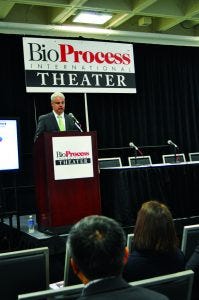- Manufacturing
- Sponsored Content
The Portrait of a Protein: Exposing Its Character with Advanced AnalyticsThe Portrait of a Protein: Exposing Its Character with Advanced Analytics
August 11, 2016
Sponsored by Fujifilm Diosynth Biotechnology
Greg Adams (director of analytical and formulation development, FUJIFILM Diosynth Biotechnologies), BPI Theater @ BIO, June 8, 2016 11:40 am –12:00 pm
 Fujifilm Diosynth Biotechnologies is a global contract development and manufacturing organization (CDMO) that has worked on multiple molecules. Adams said that proteins are complicated molecules with three dimensional (3-D) structures (primary, secondary, and tertiary) that are apt to self-aggregate. Monoclonal antibodies (MAbs), which we think of as relatively simple proteins, actually have very complex 3-D structures, with multiple chains linked by disulfide bonds, and they can be divided into multiple subclasses. A host of analytics are required to describe the function of any given protein.
Fujifilm Diosynth Biotechnologies is a global contract development and manufacturing organization (CDMO) that has worked on multiple molecules. Adams said that proteins are complicated molecules with three dimensional (3-D) structures (primary, secondary, and tertiary) that are apt to self-aggregate. Monoclonal antibodies (MAbs), which we think of as relatively simple proteins, actually have very complex 3-D structures, with multiple chains linked by disulfide bonds, and they can be divided into multiple subclasses. A host of analytics are required to describe the function of any given protein.
Fujifilm Diosynth’s analytical philosophy is driven by understanding each product’s critical quality attributes (CQAs). The company wants to be able to analyze a product consistently all the way through good manufacturing practice (GMP) manufacturing. Its analytics are driven by science, innovation, regulatory factors, and new instrumentation.
To understand a protein molecule, you need to look at it in three dimensions using a range of analytical methods. Some examples include mass spectrometry, size-exclusion chromatography, chemical denaturation showing how a molecule folds, and glycosylation profiling.
Sequence variance analysis is important in the biosimilar arena. Developers should characterize sequence variance during clone screening by looking for variance in proteins being expressed. Fujifilm Diosynth now has the techniques to look at a protein’s peptides. Its goal is to get below 1% variance in sequences. Doing so manually is a laborious and time-consuming process taking up to a week, but automated tests can reduce the time to 25 minutes.
Another approach is to characterize aggregate species by multiangle light scattering (MALS). First, the absolute molecular weight is measured while aggregates remain in
solution. Using a size-exclusion chromatogram, analysts can see different peaks. These results are sent through a MALS detector to determine the molecular weight. The weights of those different peaks show that aggregates start as dimers, transitioning to a pentameric state. This is a key test to find out how big aggregations are. Analysts then can decide whether they need to resolve the problem or can exclude the aggregates through chromatographic downstream processing.
A new stability test using a chemical denaturation technique has been available for the past 18 months. Delta G trending looks at the unfolded state of proteins in the presence of guanidine. This test detects the free energy required to unfold a biomolecule. Analysts can use the technique for buffer screening by running several tests using different concentrations of protein.
Analysts also can identify glycans present using mass spectrometry and ultraperformance liquid chromatography (UPLC). Using an automated process, they can screen 20–30 clones in one day rather than the week it takes to screen them manually.
Fujifilm Diosynth’s analytics can help clients with scaleup by making sure that they are getting the same protein and consistent quality at any scale of production.
Listen to the complete presentation at www.bioprocessintl.com/BIO2016
You May Also Like





